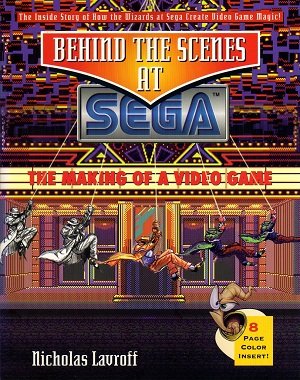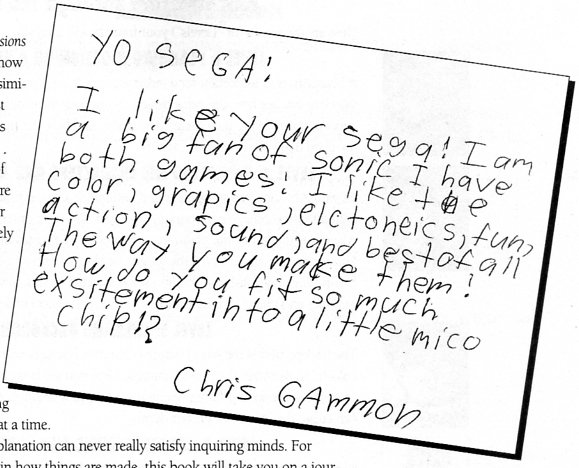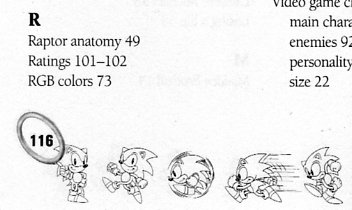
Note: Unless otherwise indicated, all scans in this article are from my own source materials, and (c) Prima Publishing.
Ladies and gentlemen, may I have your attention please? It's my profound honor to introduce to you, all the way from the year 1995, the strategy guide that's not a strategy guide!
[Wait for audience applause to die down here.]
Behind the Scenes at Sega, written by Editor-in-Chief of Sega Visions magazine (and notorious software manual creator) Nicholas Lavroff, is a guide to how video games were assembled for the Genesis/Mega Drive and Sega CD/Mega CD. Lavroff wrote the book in response to the deluges of mail Sega received from fans, mostly younger children, who were curious about how these hunks of silicon encased in plastic or pressed on optical media were produced. In the introduction, he even shows a copy of the letter with the question that kicked off the book's development:

"How do you fit so much excitement into a little microchip?"
Chris Gammon, whoever and wherever you are, thanks for penning your letter. The result is awesome.
To Guide or Not to Guide?
Before we begin, I want to make it clear this isn't a programming manual. Reading it won't enable you to actually create a game for one of Sega's consoles. It won't teach you how to lay out tile maps, program FM-synthesized music, or write Assembler code. It isn't about the nuts-and-bolts of 16-bit development.
What this book does offer is concrete examples from real-life developers and the real software they created (Earthworm Jim, Jurassic Park, Eternal Champions, etc...) to show, step by step, the process every video game went through on its way from basic pitch to final master, all written at a level suitable for anyone around ten years old and up to understand. While it obviously has a Sega-centric presentation, it's a process that pretty much every game developer in the 90's worked through, no matter on whose hardware they ultimately published.
The video game historian in me read through this book's 124 pages (116 standard pages, plus the 8-page color insert) in a single sitting, and after I finished, one thing above all else stuck out: despite countless opportunities for Lavroff to play the Marketing card and pimp Sega's hardware and diss the competition...he never does.
If you didn't live through the 90's video game heyday and Sega's rise to superstardom, you may not understand what I'm talking about, or why this is a big deal. If you want the full story, I highly recommend Console Wars: Sega, Nintendo, and the Battle That Defined a Generation by Blake Harris. Suffice it to say, Sega's marketing was as savage back then as the Wendy's twitter account is today. There was no blow too low, and no boast too loud as far as Sega was concerned, and these various campaigns ("Welcome to the Next Level", "Play It Loud", "Genesis Does What Nintendon't", etc...) all worked to undercut Nintendo, their primary competition. The swagger, the boasting, the seemingly complete lack of cares: all of this made Sega the 'cool kid' of the 90's.
And yet, reading this, you'd never know. Even the introduction, which uses its 14 pages as not just intro, but also a brief history of gaming, is remarkably neutral on the subject, pointing out that Nintendo and Sega overcame the post-crash stigma of the early 80's by focusing on quality over quantity. And while Lavroff does point out that Genesis was the number-one best-selling toy by 1992, it's simply a matter-of-fact assertion, with no implied crotch thrusting, tea-bagging, or extended middle fingers. This book is Sega going calm, and it works remarkably well to give the book a more timeless and less-dated feeling.
Behind the Scenes at Sega is broken into six different chapters (called 'Levels' by Lavroff, because video games!), and they go in order through the various phases of development: planning and design; character animation; backgrounds; music and sound; combining it all; finishing touches and beta-testing. There's also an appendix that gets a little more in-depth for the technically-inclined that explains the role of computers in the creation of console software, and an index to round things out. The index is worth reading just for the fact it includes an entry for 'Raptor anatomy', because seriously, what other video game book's going to have a page for that?

Page 49 for those reading along at home.
Guide
From my introduction, this probably wasn't a surprise. Lavroff's book isn't exactly required reading for game fans, but if you ever wondered how this stuff happens and never thought to type "how are video games made" into Google or YouTube, it's a fantastic look at the 16-bit development process, complete with tons of pictures and interviews with developers.
There's just one teeny tiny little problem...the book's been out of print for some twenty-three years. Something tells me Prima didn't foresee the demand this book would command in the twenty-first century, because right now it'll run you better than seventy freakin' dollars to add a copy to your library. Given the cover price was only $14.95, I can't in good conscience recommend tossing down this much money for a copy. I mean, it's cool, don't get me wrong, but it's not that cool.
Fortunately Prima has a workaround of sorts. They put it back in print in 2015 as a digital download, available for Kindle through Amazon. While it's not quite the same as flipping through the real thing, the digital edition will only set you back $7. That's a bit more reasonable. And hey, if people jump on this, it might convince them to bring some other books in their library back into print for new audiences as well! That would be a win-win situation for everyone, don't you think?
This sounds actually very good for the time period. (Truth be told it sounds very good even now as a historical document.) I'm surprised, impressed, and pleased that the author didn't go in with Sega's fist-to-the-face marketing, which may've defined it as the "cool kid" in the 90s but retrospectively seems silly and even laughable.
Downvoting a post can decrease pending rewards and make it less visible. Common reasons:
Submit
Yeah, it's surprisingly "un-Sega" in its coverage of Sega, if you will. The information in it is especially cool if you're at all a fan of any of the games discussed. Earthworm Jim especially has a lot of its design work shown, everything from rough pencil sketches used by the animators to bring Jim to life to the rough concepts for levels and enemies. It's solid info I've never seen anywhere else, at least not in print.
Downvoting a post can decrease pending rewards and make it less visible. Common reasons:
Submit
Congratulations, this post was rewarded with a SteemGC Upvote!
Want to meet fellow Steemit gamers and earn upvotes yourself? Join the SteemGC Discord channel!
Downvoting a post can decrease pending rewards and make it less visible. Common reasons:
Submit